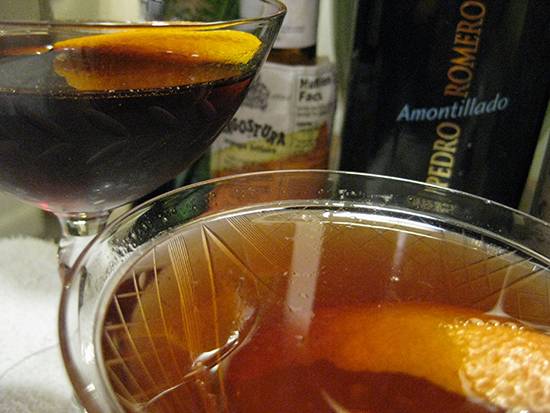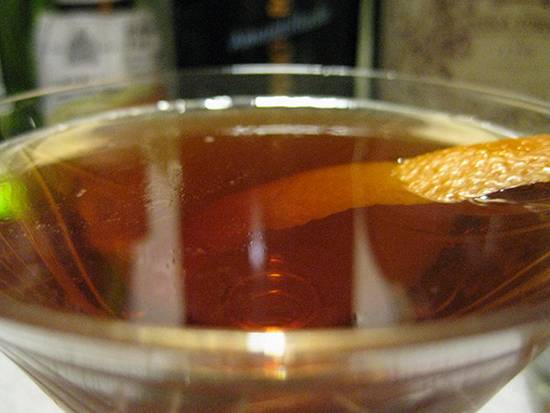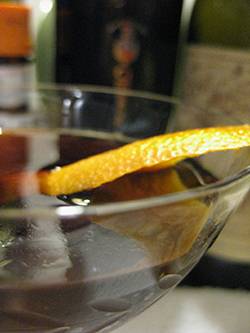Ok, so it happens to all of us. We want a drink that’s not only easy to make, but, you know, a little lighter. Maybe, for example, you went to a brewery dinner the night before and you need something that won’t bowl you over. Maybe you’re living in a 1950s sitcom, your boss is coming over, but you’re just not feeling the three-Martini dinner. Maybe you’d like a break, but still feel like a drink.
Luckily, light cocktails have a long, proud history. Vermouth became popular in the United States in the late 1800s, giving rise, of course, to Martinis, Manhattans, and, well, everything else we hold dear. Vermouth is technically an aromatized wine — a wine infused with botanicals and usually fortified with brandy or some other spirit in order to improve its keeping qualities. This lends vermouth a complexity which, while making it a perfect companion to spirits in many classic cocktails, also makes it shine in a few.

The word vermouth actually comes from the German wermut, meaning “wormwood”. There are several varieties of vermouth, most of which are available widely in the US, and all of which belong on any well-stocked bar. Dry vermouth, often called “French”, is based on white wine, is dry or off-dry, and usually has a slightly sour, mild taste, with citrus and herbal notes in the forefront. I generally buy Noilly Prat, which was recently reformulated in the US to a more traditional recipe, but Dolin dry vermouth, which is available at The Corkscrew, is a fantastic bottle. Sweet vermouth, also known as “Italian”, is also based on white wine, despite it’s red color; the color comes from additives. As the name implies, it is a sweet variety, usually with a slightly bitter edge and burnt sugar, anise, and leather flavors in the forefront. Most labels are at least decent, but I recommend the Dolin sweet vermouth, which is quite light, and Carpano Antica Formula, a more expensive bottling from Italy, which is worth drinking by itself. The least well-known variety of vermouth is white vermouth, an uncolored vermouth that is usually sweet, but less so than sweet vermouth. It usually has an orange blossom and honey character, and can make an interesting substitution for sweet vermouth in cocktails which call for it.
The other ingredient in all these cocktails is sherry, which is mostly produced in Spain. Sherry is a fortified wine, made only in the Jerez region of Spain, to which brandy is added after fermentation is complete. It is then aged further, producing a caramelized, raisiny character. There are many varieties of sherry, from extremely dry, light fino sherry to sweet, syrupy oloroso sherry. There are aperitif versions and dessert versions. The most interesting versions of sherry undergo a second fermentation with flor yeast, which produce unusual flavor compounds reminiscent of flowers, grass, and curry. Fino and Amontillado sherries are fermented with flor, and are usually available for $15-20.
In the spirit of the simplicity these cocktails convey, I’ll keep this short and sweet. These cocktails are excellent aperitifs – fairly dry and complex, without being overpowering.

The Bamboo
- 1 1/2 oz Amontillado or fino sherry
- 1 1/2 oz dry vermouth
- 2 dashes orange bitters
Combine all ingredients, stir well with ice. Strain into a cocktail glass, garnish with an orange peel.
The Bamboo is my choice for a Martini-like cocktail, dry, appetizing, and easily downable.
 The Adonis
The Adonis
- 1 1/2 oz Amontillado or fino sherry
- 1 1/2 oz sweet vermouth
- 2 dashes Angostura bitters
Combine all ingredients, stir well with ice. Strain into a cocktail glass, garnish with an orange peel.
The Adonis is obviously a kissing cousin of the Bamboo, but richer, more velvety, and a good match for anyone who feels like a lighter Manhattan. It works equally well before or after dinner.
Stephen’s Cocktail
- 1 oz Amontillado or fino sherry
- 1 oz dry vermouth
- 1 oz Benedictine
Combine all ingredients, stir well with ice. Strain into a cocktail glass, garnish with an orange peel.
Stephen’s cocktail is a little bit of an outlier, but I’m including it as a personal favorite. Benedictine, a monastery liqueur, has been made for more than 400 years. It has a sweet, honey taste, with lavender, anise, and tarragon notes (it’s actual botanical list is a jealously guarded secret). While delicious, Benedictine can be overwhelming. Stephen’s cocktail, which cleverly dilutes and pairs the Benedictine with two interesting fortified wines, highlights the flavor of the Benedictine without overwhelming. It’s sweet without being syrupy, with a complexity not achievable through other means.
So, next time you feel like a drink but need something a little lighter, try one of these. It’s much better than better than nothing.








